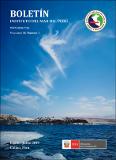Por favor, use este identificador para citar o enlazar este ítem:
https://hdl.handle.net/20.500.12958/3353| Título : | Ecología trófica de Octopus mimus Gould, 1852; Doryteuthis gahi (d’Orbigny, 1835) y Dosidicus gigas (d’Orbigny, 1835) (Cephalopoda) durante 2016 |
| Otros títulos : | Trophic ecology of Octopus mimus Gould, 1852; Doryteuthis gahi (d’Orbigny, 1835) and Dosidicus gigas (d’Orbigny 1835) (Cephalopoda) in 2016 |
| Autor : | Cisneros Burga, Rosario |
| Palabras clave : | Cefalópodos;Contenido gástrico;Calamar común;El pulpo;Calamar gigante |
| Fecha de publicación : | 2019 |
| Editorial : | Instituto del Mar del Perú |
| Citación : | Bol Inst Mar Perú. 34(1) 2019: p.165-197 |
| Citación : | Boletín IMARPE;34(1), 2019 |
| Resumen : | El pulpo (O. mimus), el calamar común (D. gahi) y el calamar gigante (D. gigas) son importantes recursos comerciales, de ahí el interés por el seguimiento de sus hábitos alimentarios. La investigación se desarrolló entre febrero y diciembre de 2016; las zonas de estudio para pulpo y calamar común fueron las islas frente a la bahía del Callao e Ilo; para el calamar gigante fueron Paita, Camaná y entre Talara y Malabrigo. Las presas dominantes fueron diferenciadas con los métodos de frecuencia de ocurrencia (%FO), numérico (%N) y gravimétrico (%P); se analizaron las tendencias del índice de repleción (IR) por sexo, desarrollo gonadal y estación. En Callao, las presas dominantes del pulpo fueron Petrolisthes desmarestii, Cycloxanthops sexdecimdentatus, Pilumnoides perlatus, Synalpheus spinifrons; en Ilo P. perlatus, Cheilodactylus variegatus, S. spinifrons. El calamar común se alimentó principalmente de teleósteos, crustáceos Panopeidae y poliquetos Nereidae. El calamar gigante de la zona norte (Paita) consumió Vinciguerria lucetia, cefalópodos indeterminados y múnida Pleuroncodes monodon; en el sur (Camaná) predominaron P. monodon y cefalópodos Chiroteuthidae; entre Talara y Malabrigo las presas dominantes fueron Nyctiphanes simplex, cefalópodos indeterminados y Cetengraulis mysticetus. Las tendencias del IR fueron variables en algunos casos, y se observó la influencia del evento El Niño 2015-2016 sobre el comportamiento alimentario.
Palabras clave: cefalópodos, contenido gástrico, presas, espectro trófico ABSTRACT: (O. mimus), common squid (D. gahi), and jumbo flying squid (D. gigas) are important commercial resources, hence the interest in monitoring their feeding habits by analyzing their stomach contents between February and December 2016. Octopus and Patagonian squid were fished in Callao Bay and Ilo, while the jumbo flying squid was caught in Paita, Camaná, and the area between Talara and Malabrigo. The dominant prey items were determined by the frequency of occurrence (%FO), numeric (%N) and gravimetric (%W) methods; besides fullness weight index (FWI) by sex, gonad and seasonal development. In octopus from Callao, the most important prey was Petrolisthes desmarestii, Cycloxanthops sexdecimdentatus, Pilumnoides perlatus, Synalpheus spinifrons; in Ilo P. perlatus, Cheilodactylus variegatus, and S. spinifrons. In Patagonian squid, the most important prey was indeterminate fish, crustacean Panopeidae, and polychaetes Nereidae. In jumbo flying squid from North (Paita), the most important prey were Vinciguerria lucetia, indeterminate squids, Pleuroncodes monodon; in the south (Camaná) were P. monodon, Chiroteuthidae cephalopods, and between Talara and Malabrigo, the dominant prey were Nyctiphanes simplex, indeterminate squids, and Cetengraulis mysticetus. The FWI tendencies were variable in some cases; in addition, the influence of the El Niño 2015-2016 on the feeding behavior was observed. Keywords: cephalopods, gastric contents, prey, trophic spectrum |
| URI : | https://hdl.handle.net/20.500.12958/3353 |
| ISSN : | 03787702 |
| Aparece en las colecciones: | Boletín 34(1), 2019 |
Ficheros en este ítem:
| Fichero | Descripción | Tamaño | Formato | |
|---|---|---|---|---|
| Boletin 34(1)-14.pdf | 1,9 MB | Adobe PDF |  Visualizar/Abrir |
Este ítem está sujeto a una licencia Creative Commons Licencia Creative Commons

